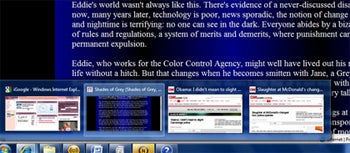The begins a tale of two operating systems: the one you want and the one you don't. It is packed with improvements and cool stuff, but it still carries a whiff of Vista that may put XP diehards off. That said, people who have gotten used to Vista will enjoy the fact that Windows 7 looks the same but acts a whole lot better.
Like many people who compute both at home and at work, I use XP and Vista as well as Mac OS X Leopard, and I like elements of all three. So I've been watching the beta and RC versions of Windows 7 very closely. Does the final "release to manufacturing" (RTM) code -- the same code that will ship with new PCs and retail versions of Windows 7 in October -- merit a jump from any of my current platforms?
Well, yes and no.
Little features like the ability to burn CDs from single ISO image files are great -- I don't need to install third-party tools to create CD-Rs anymore. And Windows 7 definitely boots up faster than XP or Vista on identically configured machines. You can't knock the advantage of 60 seconds less boot time.
But grrr! Just when things were going well, I tried to do a little light video editing, only to discover that Windows Movie Maker isn't included with Windows 7. It's now part of Microsoft Live, and it's still in beta. In its present form, it's much less capable than the app that ships with XP. So after ten minutes with Windows 7, I found myself booting up an old XP machine for an everyday task.
(I later discovered that there is a that works with Windows 7, although Microsoft's doesn't list Windows 7 among the supported OSes. Nevertheless, it's not nearly as elegant as having it included with the OS.)
What other joys and disappointments does the new Windows bring?
Finding stuff is easier...
Keeping track of your work is always going to be a chore. Fortunately, Windows 7 concentrates much of its efforts on making files accessible. Windows 7 clusters different file types into shortcuts called Libraries -- they look like Vista's Documents, Pictures and Videos folders, but they lead to files of the pertinent type whatever folder they are actually located in. You can add your own folders to Libraries at will to keep your project files accessible.
Then there are Jump Lists, a zippier way of previewing your open applications and folders. Moving a mouse over the taskbar pops up easy-to-scan lists of open windows, and right-clicking on them shows not only what's running, but a brief history of what you've done with those programs -- files opened, sites visited, and other handy pointers. That feature alone has the makings of a much more efficient workday.

And Windows 7's Search is streets ahead of earlier iterations: Like Mac OS X's Spotlight, it begins delivering results as you type -- before you've even finished a word -- and narrows the list as you enter more characters. You can also preview the contents of search results before deciding to open them.
Chalk up several productivity pluses for Windows 7.
...but it's just as tough to find the right version of the OS
When Windows Vista was released, one of the loudest complaints was about the overwhelming array of versions it came in. And while XP didn't initially ship with quite as many flavors, later additions such as the Media Center, Tablet PC and Professional x64 editions upped its version count as well. Despite pleas from pundits to available for Windows 7, however, things haven't gotten any simpler.
There's a Starter Edition for netbooks, two Home versions (Home Basic and Home Premium), plus a Professional, an Enterprise and an Ultimate edition. (There has been some confusion about whether there will be different versions for the European Union to comply with EU regulations; the latest from Microsoft appears to be that as elsewhere.) And, of course, most of these are available in both full versions and lower-priced upgrade versions for people with licensed retail copies of Windows 2000, XP or Vista.

No comments:
Post a Comment